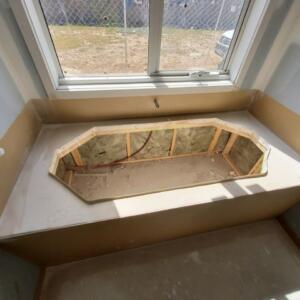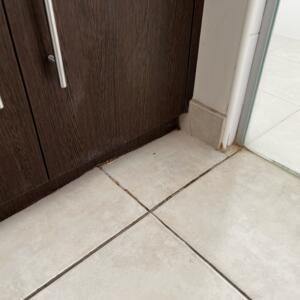Waterstops in bathrooms
Waterstops are necessary in all bathrooms (unless flexible waterproof sheet flooring is used), yet surprisingly many trades, builders and site supervisors, don’t understand their importance or the requirements of their installation. We often see waterstops that are incorrectly installed or missing altogether so we have written this piece with the goal of educating and increase awareness to homeowners, builders and trades. Not only are waterstops important to protect non-wet areas of your home from damage, they are also a mandatory requirement and must be installed to achieve compliance with the National Construction Code.
What is a waterstop?
As defined by Australian Standard AS 3740: 2021 Waterproofing of domestic wet areas – “Waterproofing of domestic wet areas, a waterstop is a vertical extension of the waterproofing system forming a barrier to prevent the passage of moisture in the floor or vertically in a wall.”
As defined in AS3740, a waterproofing system is a combination of elements that are required to achieve a waterproof barrier. For example, substrate, membrane, bond breakers, waterstops, sealants and finishes.
Waterstops are used as part of a waterproofing system to prevent water/moisture under the finished surface from escaping the wet area and causing damage to other materials and structural building elements. This water can occur from shower use, water spills from basins, showers and baths. Water can also occur from slow leaks that have gone unnoticed from toilets, sink wastes and tap fittings.
Where are waterstops located in bathrooms?
Waterstops are required at various junctions throughout a dwelling including bathrooms, WC’s, powder rooms, ensuites and laundries.
They are required at wet area doorways, around the perimeter of baths which are installed on a hob, and around the perimeter of showers. The location and height of the waterstop for a shower depends on number of factors for example is there is set down, is the shower area unenclosed/enclosed, is it frameless/semi-frameless/framed etc.
Who installs the waterstop?
Waterstops must be installed by the waterproofing installer to ensure compatible products are used to ensure a “waterproof seal” and “integral” with the perimeter flashing. Unfortunately, we commonly find waterstops are installed by tilers or builders after the waterproofing membrane has been applied. Whilst it aesthetically suits tile layout, it is highly likely water can escape causing damage to other building elements. Essentially an incorrectly installed waterstop is just as effective as no waterstop.
It’s important to keep in mind that it is very possible that if the installer has not installed the waterstops, the installation of other waterproofing elements may also not have been performed in a compliant manner.
A certificate should be supplied by the qualified waterproofing installer, noting that the required waterstops have been installed. However, we see many instances where these certificates are issued when non-compliant waterstops are evident.
How do I know if my waterstops have been installed correctly?
Waterstops should be visible at the waterproofing stage of construction, prior to the tiling commencing. They must be sealed to the perimeter flashing of the wet area and the waterproofing membrane applied all the way to the top edge of the waterstop. After the tiling has been completed, they typically remain visible at doorways and at shower openings for stepless (flush) showers.
Waterstops are generally not visible after the bath has been installed onto the hob or after a framed shower screen has been installed. The best way to ensure your waterstops (and other essential waterproofing elements) are installed correctly in your home is to have an independent building inspection at the waterproofing/fix stage of construction.
What could happen if I don’t have a waterstop?
Waterproofing is by far the most common defect when it comes to new homes with 23 per cent of recently completed buildings having faulty waterproofing (See link). From a sample of our recent Waterproof/fix inspections we wound that 92% of jobs where waterproofing has been installed in a non-compliant manner.
If a waterstop is not installed, water has the opportunity to travel underneath the finished tiled flooring and escape into non waterproofed areas causing damage to carpets, skirting boards, plaster, and timber framing. This can cause rot which effects the structural integrity of the home and/or promote mould and bacteria to grow which is a very serious health concern.
Repairing problems that arise if a waterstop has been missed can be costly, it is not possibly to simply add one in. Installing a waterstop after a wet area has been finished requires removal of tiles which can damage the waterproof membrane and, in some cases, will result in the whole bathroom needing to be stripped out.
Water damage can lead to disagreements and disputes between homeowners and builders or insurance companies. Sometimes homeowners are blamed that the issue was their fault, a result of poor maintenance or not identifying the leak quick enough. It can be hard to know where to turn. Disputes are physically, emotionally, and financially exhausting. If unable to be resolved, individuals may find themselves heading to DBDRV and down the legal path to VCAT where really no one is a winner. It’s amazing to think how an inexpensive piece of aluminium could prevent a great deal of stress and turmoil to all parties.
Got concerns or want to know more? Get in touch with us.


















